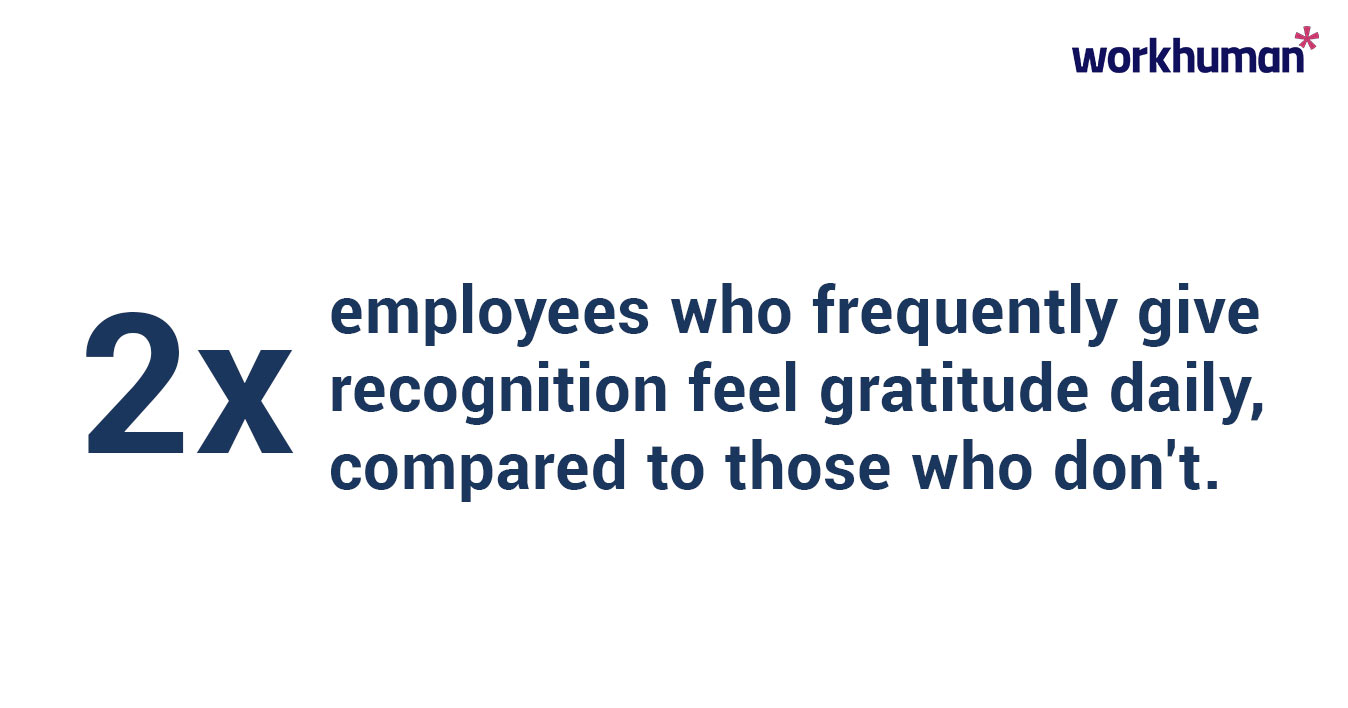How Recognition Can Help Reduce Stress and Burnout

Burnout is rampant in the world of work. In a 2023 survey, over 40% of the 10,000+ respondents said they were burned out, up four percentage points from an equivalent 2021 survey. Burnout makes everything at work harder: concentration, motivation, engagement, productivity, you name it.
Organizations must learn how to both prevent and treat burnout, because it’s guaranteed to be already present in your workplace and it’s guaranteed to be present in the future. Let’s dive into how recognition can help reduce stress and burnout at work.
Defining burnout
Burnout is defined by the World Health OrganizationOpens in a new tab (WHO) as an occupational phenomenon “conceptualized as resulting from chronic workplace stress that has not been successfully managed.” The syndrome includes feelings of exhaustion or depletion, increased mental distance from or negative feelings towards one’s job, and lower professional efficacy.
How burnout impacts the workplace
When you think of burnt-out employees, what do you picture? Following the WHO’s definition, these people are exhausted, resentful, and unproductive. They struggle to focus and complete tasks. They are less present and engaged than their peers. In short: they’re not giving their all because their “all” (their full threshold) is too greatly diminished.
Employees who are burned out much or all of the time don’t bring their best self to work. In fact, they’re 63% more likely to not show up at all and more than twice as likely to look elsewhere for a job.
Burnout is costly for everyone involved. Voluntary turnover due to burnout alone costs an organization 15% to 20% of the payroll budget each year. When employees are frayed and disengaged, organizations suffer for it.
Protecting employee wellbeing adds up to hundreds of millions of dollars saved annually, because thriving employees are primed to perform and excel. They feel more fulfilled at the office and are generally more motivated to do good work. That’s why it’s so crucial to prioritize wellbeing at work. So, how can you do that?
Recognition: the burnout antidote
Employee recognition, which helps workers feel seen and appreciated, is the antidote for burnout. According to this study with Gallup and Workhuman, fulfilling employee recognition is associated with better employee wellbeing by:
- Increasing overall life evaluations: Employees are as much as two times as likely to evaluate their lives and futures positively.
- Reducing levels of burnout: Employees are up to 90% less likely to report being burned out at work “always” or “very often.”
- Improving daily emotions: Employees are about 40% less likely to report having experienced a lot of stress, worry, and sadness.
- Improving social wellbeing: Employees are seven times as likely to strongly agree that they have meaningful connections or a best friend at work, and as much as ten times as likely to strongly agree that they belong.
A culture of appreciation is key to making team members feel valued. People want to feel a sense of connection to their work, as well as to their colleagues, and recognition fuels both. It reinforces the idea that everything you do at work – as well as how you do it – matters, from supporting a teammate to going above and beyond on a project or reaching a certain milestone.
Recognition shields employees from burnout by boosting their interest in their work, encouraging appreciation among peers, and furthering a culture of positivity. This sense of connection is what buoys them through difficult moments and protects them from swinging too far into high stress.
How to wield recognition to mitigate burnout
Burnout is (somewhat) inevitable; it’s not if but when and how it affects your workplace. So it’s best to act like it’s already here (because it is) and take steps to both treat and prevent it to avoid greater spread.
In order for recognition to have the intended effect, though, it needs to fulfill these five pillars, as identified by Gallup: fulfilling employees’ expectations, authentic, personalized, equitably distributed, and embedded in an organization’s culture.
Here are some tips for strategic employee recognition to prevent and treat burnout.
Make work flexible
Employees really care about having a say in how they work. In fact, a Workhuman survey found that feeling appreciated and valued for the work they do is the most important factor (39%) aside from pay that would influence an employee’s decision to stay with a company.
Work-life balance is probably one of the first factors you think of when it comes to burnout, and that’s for a good reason. Long hours, untenable workloads, and unreasonable expectations all contribute significantly to burnout.
Instead of focusing on how many hours employees work, focus on their quality of work and encourage time off to refresh and recharge. Remember that every employee has a unique working style. Operating within that reality instead of fighting it will be more beneficial to everyone in the long run.
You can foster this culture of healthy working hours by providing mandated paid time off, like half days on Fridays, and providing additional paid leave for mental health days (and reminding employees that they should use it!). Encourage managers to share when they are using these mental health days so they can inspire their team members to do the same.
Give recognition regularly and authentically.
Regularity and authenticity are crucial to an effective recognition program. Employees who report giving recognition a few times per month or more are nearly 2x as likely to say they experienced gratitude the day before. That’s right: giving recognition is just as impactful as receiving it.

Gratitude is the ultimate burnout anecdote. It helps foster a sense of connection to the present and, of course, breeds appreciation. And when shared, it cultivates a culture where people feel seen and heard, boosting trust and belonging among teammates.
This is why it’s just as important to encourage employees to give one another recognition as it is for managers to recognize their team members (more on that in a moment). Recognition isn’t about hierarchy – it’s about spreading goodwill throughout the organization because there is value in appreciation across the board.
Ensure managers and leaders know their role.
Managers and leaders carry significant influence when it comes to recognition, and they should wield that responsibility seriously. Their behaviors exemplify organizational values to the rest of the team, so it’s crucial that they engage meaningfully and regularly with your recognition program.
Employees who report receiving recognition from managers and leaders at least a few times a month are up to twice as likely to be thriving. Just as harsh words and unrealistic timelines breed stress, feeling encouraged and seen by your manager is a surefire way to feel supported at work and prevent excess stress.
Leaders need to demonstrate active and ongoing participation in recognition in order for it to become and remain a mainstay in organizational culture.
Make your recognition equitable.
Recognition bolsters a sense of belonging at work, which plays a big role in equity. Employees who strongly agree that they receive the right amount of recognition for the work they do are four times more likely to perceive their workplace as inclusive.
Because women and employees of color are historically excluded in the workplace, it is crucial to ensure your recognition is equitable across the board. This is why recognition data is important. It enables you to see recognition and reward distribution so you can identify gaps and make a plan to address them.
You might feel like you’re being fair – and you probably have every intention to be! – but it’s important to use factual data to make more informed decisions and make your recognition program even more effective.
Conclusion
Getting recognized makes employees more resilient and motivated, making them more likely to meaningfully engage with their work. When you see someone at work who looks like they are stressed, upset, or burned out, recognize them! Find an excuse to tell them about good work they’ve been doing or a way they’ve helped you recently. Don’t be afraid to show that you care and give someone a much-needed boost.
About the author
Maeve Ginsberg
A wellness enthusiast and the mid-day walk’s #1 fan, Maeve champions work-life balance.
Having gone from a corporate job to self employment, Maeve has lived through countless working styles. This evolution forced confrontation of her own limiting beliefs, eventually breeding a completely individualized approach to work and productivity.
As a Senior Copywriter, Maeve often writes on workplace wellbeing and strives to advocate for all workers and leaders to find small yet significant ways to make their work lives healthier and more fulfilling.
Offline, Maeve enjoys testing new cuisines and hanging upside down off walls (also known as bouldering).